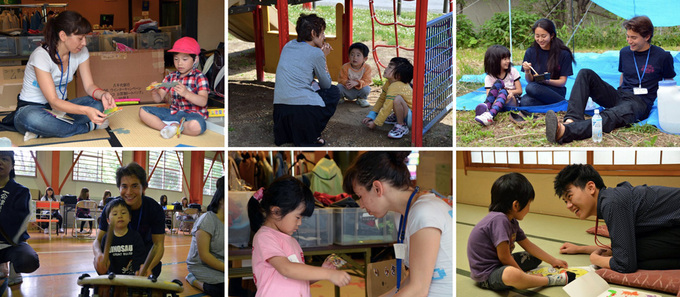Volunteers from Abroad Reach out to Children in Tohoku
Noriko Yoshimoto
Director, Never-ending International workCamps Exchange (NICE)
When a major earthquake and tsunami struck eastern Japan on March 11, 2011, it was not only Japanese people who were affected by the disaster. Many foreign residents sought refuge elsewhere or returned to their home countries. Yet, Leah, an American woman teaching English in Tokyo, wanted to find some way to help children in stricken area. On April 25 she went to Aizuwakamatsu City in Fukushima Prefecture to take part in a project to play with children in evacuation centers.
Approximately 10,000 evacuees from the Hamadori area are staying in the Aizuwakamatsu region, roughly 15-20% of them children of junior high school age or younger. Kazuya Egawa, director of the NPO "Terakoya Houjousha" which runs an independent school in Aizuwakamatsu, quickly became aware of the need to provide care for these children who were unable to go to school and had no idea when they could go back home.
Soon after the earthquake, he used Twitter to recruit volunteers among the staff at Terakoya Houjousha, as well as local high school and college students. They took turns going to the three refugee centers in the city from 10 am to 4 pm every day, playing with the children and talking to them. In April he opened a special volunteer camp for disaster reconstruction in collaboration with the international volunteer programs. They immediately began accepting volunteers from around the country and around the world.
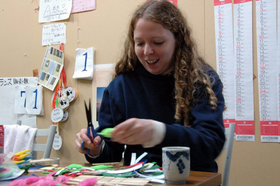 Leah was the first non-Japanese to participate in the camp. She had been living in Japan for eight years, teaching English to children. When she told her friends and the parents of her students that she was going to Fukushima, they donated toys and picture books. She packed them into a big suitcase, along with the stickers and homemade games she used in her lessons.
Leah was the first non-Japanese to participate in the camp. She had been living in Japan for eight years, teaching English to children. When she told her friends and the parents of her students that she was going to Fukushima, they donated toys and picture books. She packed them into a big suitcase, along with the stickers and homemade games she used in her lessons.
When asked if her husband and family disagreed with her decision to go to Fukushima, she laughed and said, "My family in the U.S. did. The news coverage in America was different from here in Japan, and a lot of what they heard was exaggerated or wrong. I explained that to them and finally they understood. My husband wanted to go with me, but he had to work."
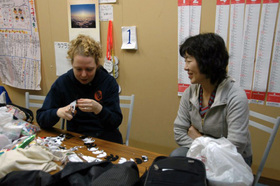 Leah has no problem speaking Japanese in everyday conversation, but if the subject got difficult, a Japanese volunteer would help her. Keiko, a housewife in her 50s from Hyogo prefecture, was drawn naturally to the role of interpreter. When we asked Keiko whether she minded sleeping on the floor in a sleeping bag in Aizu's chilly April weather, she replied, "My parents' house was destroyed in the Great Hanshin-Awaji Earthquake. That experience made me want to do something. If I hadn't been affected by that earthquake, I wouldn't have come to Fukushima." Although she says she is not good at playing with children, Keiko's enthusiastic contributions in the kitchen and as an interpreter make her presence indispensable for the student volunteers.
Leah has no problem speaking Japanese in everyday conversation, but if the subject got difficult, a Japanese volunteer would help her. Keiko, a housewife in her 50s from Hyogo prefecture, was drawn naturally to the role of interpreter. When we asked Keiko whether she minded sleeping on the floor in a sleeping bag in Aizu's chilly April weather, she replied, "My parents' house was destroyed in the Great Hanshin-Awaji Earthquake. That experience made me want to do something. If I hadn't been affected by that earthquake, I wouldn't have come to Fukushima." Although she says she is not good at playing with children, Keiko's enthusiastic contributions in the kitchen and as an interpreter make her presence indispensable for the student volunteers.
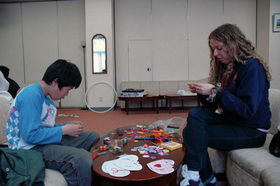 The volunteers held a meeting every morning to find out where they would be going that day. Two or three people went to each evacuation center, taking tea and rice balls with them, to play with the children until late afternoon.
The volunteers held a meeting every morning to find out where they would be going that day. Two or three people went to each evacuation center, taking tea and rice balls with them, to play with the children until late afternoon.
At first, the children eyed Leah from a distance, startled by her blue eyes and blond hair, but soon they nicknamed her "Eigo-chan (English buddy)" and started to play. The alphabet stickers and animal board game that Leah had brought were big hits. Some children drew pictures of Leah and gave them to her as presents. Their mothers began chatting with her too, saying "Where do you live?" and "Your Japanese is very good."
At the end of each day, all of the volunteers got together to discuss the children and parents at each center, and to share their impressions. Leah asked "Is it okay to scold the kids when they don't put their things away?"
"The kids in the evacuation centers are ordinary kids. If they're bad, you should scold them."
"Invite them to help you clean up, and when they do, praise them. When you do that, it gives them a sense of accomplishment. I don't think it's good for the volunteers to do everything for them."
Other volunteers give their opinions, and Egawa offered advice. The meetings sometimes lasted up to an hour.
I met Leah in Tokyo again after she'd finished two weeks of volunteering. She commented: "Actually, I don't have that many Japanese friends, and up to now I'd thought that Japanese people seemed nice and kind on the surface, but I never knew what they were thinking inside. As I spent time with the evacuees and volunteers, I learned that most of them are kind and thoughtful on the inside too. My two weeks in Aizuwakamatsu changed my impression of Japanese people." She went on to say, "I'm going to Ishinomaki next week. It's the same kind of volunteer work with children at evacuation centers." Afterwards, Leah went with her husband, also an American, to Ishinomaki three times, Kesennuma twice and Minamisanriku once, to do more volunteer work, and visited Aizuwakamatsu again.
Many volunteers from other countries including the U.S., Hong Kong and France have visited Aizuwakamatsu since Leah left. Although most can't speak Japanese, they play with the children and continue their volunteer activities. Esther, a company employee from Hong Kong, couldn't get three weeks off work, so she quit her job to come to Japan. She said, "I thought I would regret if I didn't come. I'll work in Hong Kong again for a while and definitely come back to Aizuwakamatsu."
Jackie, a yoga instructor from New York, rewrote all the English language information for recruiting volunteers, saying "Americans are logical people. So you should explain more clearly how many kilometers Aizuwakamatsu is from the Fukushima reactor, what the situation is now, and why it is safe to come here."
A graduate student from Hong Kong, Walter could not speak a word of Japanese when he came to Japan, but in two weeks made enough progress to handle simple conversations. He went back to Hong Kong once, and returned in August through a workcamp organized by NICE. He stayed in Rikuzentakata City, Iwate Prefecture where he helped clear away rubble.
Although there is no end in sight for the victims of the disaster, many express gratitude to the volunteers from overseas, saying "We really appreciate these people who have traveled such a long distance to help us." Taking care of children like this is not a high-profile activity, and the results are hard to measure, but it is essential. The work of these volunteers is still going on in Aizuwakamatsu and many other places throughout eastern Japan.
Never-ending International workCamps Exchange (NICE)
This nonprofit organization runs projects called workcamps in which young volunteers from all over the world live and work together with local communities for two to three weeks. In late September, NICE launched "Special Networking International Workcamps for Revival from the Disasters" with financial aid from the Japan Foundation Center for Global Partnership. Through the program, volunteers from countries frequently hit by natural disasters participate in long-term activities in Japan.
Reconstruction Assistance for Fukushima: Letters from Shelters
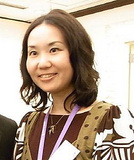 Noriko Yoshimoto
Noriko Yoshimoto
Director, Never-ending International Workcamps Exchange
She started to get involved in international volunteering when she was a university student. In 2001 she was sent by NICE to the Coordinating Committee for International Voluntary Service (CCIVS) under UNESCO, to work as a coordinator for the Asia-Europe Young Volunteers Exchange. Since 2002 she has been serving as the director of NICE. In 2011, she went to Aizuwakamatsu City in Fukushima Prefecture right after the earthquake and has been staying there to work as a coordinator for a special volunteer camp for disaster reconstruction.
Keywords
Back Issues
- 2019.8. 6 Unraveling the Maker…
- 2018.8.30 Japanese Photography…
- 2017.6.19 Speaking of Soseki 1…
- 2017.4.12 Singing the Twilight…
- 2016.11. 1 Poetry? In Postwar J…
- 2016.7.29 The New Generation o…
- 2016.4.14 Pondering "Revitaliz…
- 2016.1.25 The Style of East As…
- 2015.9.30 Anime as (Particular…
- 2015.9. 1 The Return of a Chin…



